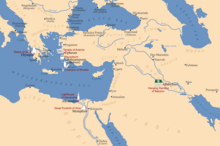
The seven wonders of the ancient world they were listed in some of the earliest guidebooks for travelers, in the first or second century BC. These guides were written in Greek and only covered the region around the eastern part of the Mediterranean Sea.
The best known version was:
 Pyramid of Cheops to Giza (Egypt): represents the glorification of the pharaoh's exploits.
Pyramid of Cheops to Giza (Egypt): represents the glorification of the pharaoh's exploits.- Hanging Gardens of Babylon (Mesopotamia): where it is said that Queen Semiramis collected fresh roses throughout the year.
- Zeus statue in Olympia (Greece): great testimony of religious art, the work of the Greek sculptor Phidias.
- Temple of Artemis to Ephesus (Turkey).
- Colossus of Rhodes to Rhodes (Greece): huge bronze statue located on the homonymous island.
- Mausoleum of Halicarnassus (Turkey): monumental tomb where the satrap Mausolo rests, located ad Halicarnassus.
- Lighthouse of Alexandria to Alexandria (Egypt): construction that illuminated the way to the merchants who approached the port.

Hanging Gardens of Babylon

Colossus of Rhodes

Mausoleum of Halicarnassus

Temple of Artemis in Ephesus

Lighthouse of Alexandria, Egypt

Zeus statue in Olympia

Pyramid of Cheops in Giza
None of these wonders have survived to this day, except the Pyramids, which ironically were the oldest at the time of writing the list.
In later times there have been various proposals to list the "Seven Wonders" in various regions or around the world. With no universally defined criteria for including locations, the selection of seven important destinations for these lists tends to be arbitrary and widely variable. As a way of saying, a work of extraordinary beauty is sometimes referred to as an "eighth wonder of the world".
There is a proposal to build a new one Colossus of Rhodes.
Related items
Other projects
 Wikipedia contains an entry concerning Seven wonders of the ancient world
Wikipedia contains an entry concerning Seven wonders of the ancient world Commons contains images or other files on Seven wonders of the ancient world
Commons contains images or other files on Seven wonders of the ancient world







